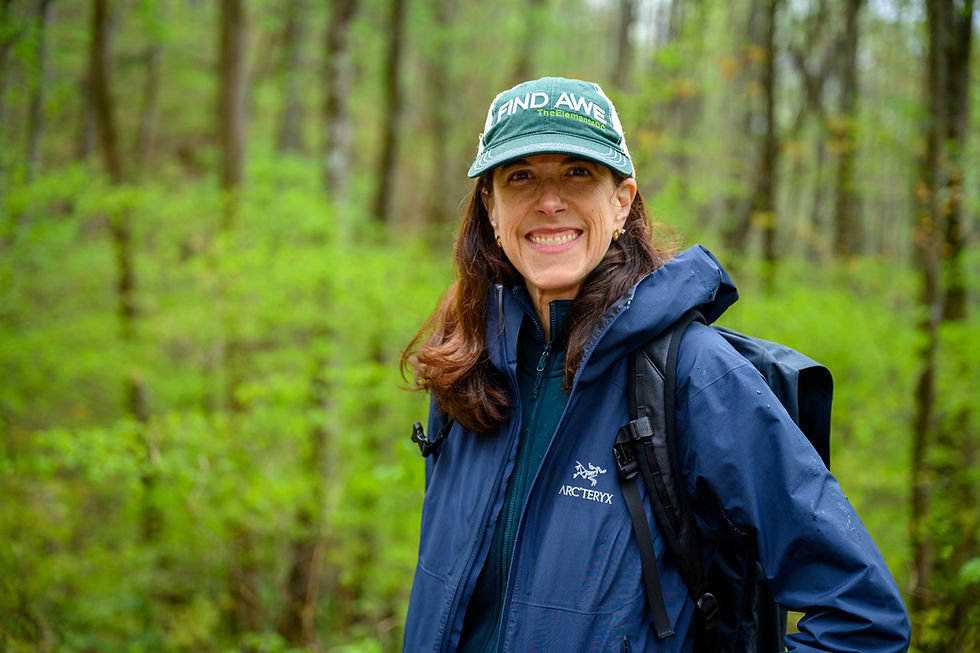The Appalachian Trail is Important for More Than Pretty Views
- hikingresearch
- Dec 23, 2022
- 4 min read
By Mark Ellison
The Appalachian Trail (A.T.) was never envisioned to be a narrow corridor squeezing through a vast urban jungle. Instead, it was built to conserve and traverse the last remaining contiguous open space in the eastern United States, a natural oasis and an escape from the sights, sounds, pollution and stress of contemporary life. It is regularly my escape and one I do not take for granted.

View from the Sawteeth
And through this work, it was constructed to preserve experiences: viewing the seemingly endless bucolic mountain ranges in the Shenandoah, standing in the silence of a grove of spruce trees on Mt. Guyot, listening to the gentle whisper of a cool mountain stream, enjoying the scent of the forest after a rain, watching water cascade over a majestic waterfall or reflecting on top of Katahdin after completing a life changing journey.
These sensory experiences are seared into our memory, held deep in our heart, and are a source of inspiration and cause for celebration. These experiences were part of Benton MacKaye’s vision for the Trail in 1921, but it has always been about creating something more than just a footpath. MacKaye believed “a realm and not merely a trail marks the full aim of our efforts.” And while we celebrate the 100th anniversary of this vision, it is also a reminder of just how much is left to do to ensure the A.T. “realm” is conserved and nurtured so that it can achieve its full potential.
Millions venture on to the AT each year seeking experiences that are only possible because of an evolving realm that helps protect the trail. Conservation along the trail realm is about protecting the wilderness environment which helps provide opportunities for positive user experiences while also building a strong network of communities along the trail.

Near Stecoah Gap
A.T. Environments: Keeping the Trail’s Lands Wild
The ATC’s mission to protect, manage, and advocate for the 2,193 mile Trail is being challenged on multiple fronts. The Trail is protected by federal law, but many of the wild, scenic and culturally significant landscapes within its realm are threatened by an advancing human footprint. In 1921 the U.S population was 108 million, and it now tops 333 million, greatly increasing trail usage and the demand for natural resources which can erode the quality of the experiences so many seek. Coupled with a changing climate, the loss of unfragmented forestlands that buffer the impacts of change, inappropriately sited commercial and residential development, incompatible energy development, communications towers intruding on scenic vistas, and the destruction of diverse wildlife and plant habitats, the threats are daunting. All of these directly impact trail realm ecosystems and how we experience the trail.
The first line of defense since the Trails inception has been legions of volunteers who embrace the opportunity to protect the resources it encompasses and experiences it nurtures. This is bolstered from the support of over 100 public agencies and non-profits involved as well. The Clean Water Act, Land and Water Conservation Fund, and the Restore our Parks Act all also provide support.
Beyond its role as a footpath, the A.T. also creates an ecological corridor linking an array of biological diversity. Botanically rich forests, crystal clear streams, vigorous native plants, melodic birds and robust animal life not only provide the exhilarating experiences many seek but are also the backbone and heart of a resilient environment that our species and many others need to survive and thrive in the future. Expanding the realm helps to ensure a healthy forest community and the unforgettable peak experiences that are built off of this.

View from Cheoah Bald
A.T. Communities: Gateways to the A.T. Experience
In addition to offering recreational opportunities and promoting conservation the AT also serves to connect rural communities, farms, and forests. Having ecosystems around the trail that are resilient attracts visitors who provide a much-needed economic infusion to small community economies in places like Franklin, Hot Springs, Damascus and Harpers Ferry which serve as gateways to experiences of a lifetime for many on the Trail. The Trail and adjoining communities form a symbiotic relationship supporting tourism, conservation and responsible recreation.

Near the "original" Charlies Bunion
The A.T. Landscape: More than a pretty view
The AT hiking experience is about more than the panoramic views, it is about entering an ecosystem that is profoundly different than urban life. Continuing to have access to these experiences requires advocating for better regulations and encroachment protections, realizing that once it is gone, we can’t get it back. Our well-being has always been closely linked to the health of the natural environment. Everyone who lives, works and plays in the Appalachian Mountains has a vested interest in ensuring a vibrant future for the AT Realm. Protecting the realm, the biodiversity it nurtures, the experiences it fosters and the communities it supports will help secure for current and future generations the opportunity to bask in the vast bucolic beauty that only a resilient and expanded Appalachian Trail realm provides.








Comments